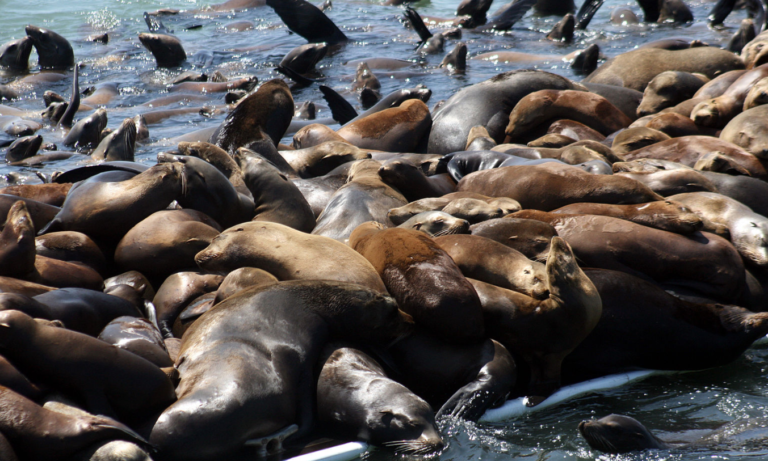Toxic Algae Bloom: Devastating California Coast Marine Life

Table of Contents
California's stunning coastline, a vibrant ecosystem teeming with life, is increasingly threatened by a devastating phenomenon: toxic algae blooms. These harmful algal blooms (HABs), fueled by factors like climate change and nutrient runoff, are causing widespread damage to marine life and posing significant risks to human health and the state's economy. This article will explore the devastating impact of toxic algae blooms on California's coastal ecosystems and the urgent need for effective mitigation strategies.
<h2>The Causes of Toxic Algae Blooms in California</h2>
Understanding the root causes of toxic algae blooms is crucial to developing effective solutions. Several interconnected factors contribute to their proliferation along the California coast.
<h3>Nutrient Pollution</h3>
Excessive nutrients, primarily nitrogen and phosphorus, act as fertilizers for algae, stimulating rapid and unchecked growth. These nutrients enter coastal waters through various pathways:
- Increased fertilizer use in agriculture: Intensive farming practices contribute significantly to nutrient runoff into rivers and streams, ultimately reaching the ocean.
- Inadequate wastewater treatment: Inefficient sewage treatment plants release untreated or partially treated wastewater containing high levels of nutrients into coastal waters.
- Stormwater runoff carrying pollutants from urban areas: Urban runoff carries fertilizers, pet waste, and other pollutants from streets and parking lots, enriching coastal waters with nutrients. This is exacerbated during heavy rainfall events.
<h3>Climate Change</h3>
Climate change is significantly altering ocean conditions, creating a more favorable environment for toxic algae blooms:
- Rising sea surface temperatures: Warmer waters accelerate algal growth and metabolism, leading to larger and more frequent blooms.
- Changes in ocean stratification: Altered water column stratification can trap nutrients near the surface, further fueling algal growth.
- Increased frequency and intensity of extreme weather events: More frequent and intense storms can increase nutrient runoff, while changes in ocean currents can transport algae to new areas.
<h3>Upwelling</h3>
While a natural oceanographic process, upwelling can exacerbate the problem:
- Increased frequency or intensity of upwelling events due to climate change: Climate change may be influencing the frequency and intensity of upwelling, bringing nutrient-rich deep waters to the surface and triggering larger toxic algae blooms.
<h2>The Devastating Effects on Marine Life</h2>
The consequences of toxic algae blooms on California's marine ecosystems are severe and far-reaching.
<h3>Mass Mortality Events</h3>
Many species of algae produce potent neurotoxins that can be lethal to marine organisms:
- Examples: Dead zones in coastal areas: Large areas of depleted oxygen, caused by decaying algae, create “dead zones” where marine life cannot survive.
- Stranded marine mammals and seabirds: Exposure to toxins can cause neurological damage, leading to disorientation and strandings.
- Reduced fish populations impacting fisheries: Fish kills due to toxic algae blooms can have devastating consequences for commercial and recreational fisheries.
<h3>Disruption of Food Webs</h3>
The death of key species has cascading effects:
- Impacts on shellfish populations and human consumption safety: Shellfish accumulate toxins, posing risks to human health and the shellfish industry.
- Decreased prey availability for larger predators: The decline in fish and other prey species affects the survival of larger predators, disrupting the entire food web.
- Long-term effects on biodiversity: Repeated toxic algae blooms can lead to a loss of biodiversity and alter the structure of marine communities.
<h3>Shellfish Contamination</h3>
Shellfish are particularly vulnerable:
- Risk of paralytic shellfish poisoning (PSP): Consumption of contaminated shellfish can cause serious illness, even death.
- Economic consequences for the shellfish industry: Shellfish harvesting closures due to contamination can cause significant economic losses.
- Public health concerns and beach closures: Toxic algae blooms necessitate beach closures and public health advisories, impacting tourism and recreation.
<h2>Mitigation and Management Strategies</h2>
Combating the threat of toxic algae blooms requires a multi-pronged approach.
<h3>Reducing Nutrient Runoff</h3>
Minimizing nutrient inputs is essential:
- Improved fertilizer management techniques: Promoting sustainable agricultural practices and reducing fertilizer overuse.
- Investment in advanced wastewater treatment facilities: Upgrading wastewater treatment plants to remove more nutrients before discharge.
- Construction of stormwater retention ponds and wetlands: Creating natural filtration systems to trap nutrients before they reach coastal waters.
<h3>Monitoring and Early Warning Systems</h3>
Early detection is key:
- Satellite imagery and remote sensing technologies: Using remote sensing to monitor large areas of the ocean and detect blooms early.
- Citizen science initiatives: Engaging the public in monitoring and reporting toxic algae blooms.
- Real-time monitoring of water quality parameters: Implementing continuous monitoring of key water quality indicators to provide early warnings.
<h3>Public Education and Awareness</h3>
Public engagement is crucial:
- Public health advisories and beach closures: Providing timely warnings to protect public health and safety.
- Educational campaigns targeting communities and stakeholders: Raising awareness of the causes and impacts of toxic algae blooms.
- Promoting sustainable practices in coastal communities: Encouraging responsible behaviors to reduce nutrient runoff and protect coastal waters.
<h2>Conclusion</h2>
Toxic algae blooms pose a significant and growing threat to California's coastal ecosystems and human health. Addressing this challenge requires a multifaceted approach that includes reducing nutrient pollution, improving monitoring and early warning systems, and increasing public awareness of the risks. By implementing effective mitigation strategies and collaborating across sectors, we can work to protect our precious marine resources and prevent further devastation caused by these harmful toxic algae blooms. Let's take action to safeguard our California coastline from the harmful effects of harmful algal blooms and ensure a healthy future for our oceans.

Featured Posts
-
 Imunisasi Anak Rendah Kasus Suspek Campak Di Pohuwato Melonjak
May 30, 2025
Imunisasi Anak Rendah Kasus Suspek Campak Di Pohuwato Melonjak
May 30, 2025 -
 Steffi Graf Und Andre Agassi Enthuellen Ihre Pickleball Formel
May 30, 2025
Steffi Graf Und Andre Agassi Enthuellen Ihre Pickleball Formel
May 30, 2025 -
 Understanding And Avoiding San Diego International Airport Flight Delays
May 30, 2025
Understanding And Avoiding San Diego International Airport Flight Delays
May 30, 2025 -
 Air Jordan June 2025 Releases Dates Styles And Where To Buy
May 30, 2025
Air Jordan June 2025 Releases Dates Styles And Where To Buy
May 30, 2025 -
 Gorillaz 25th Anniversary House Of Kong Exhibition Information
May 30, 2025
Gorillaz 25th Anniversary House Of Kong Exhibition Information
May 30, 2025
Latest Posts
-
 Seattles Wet Weekend Rain Forecast Extended
May 31, 2025
Seattles Wet Weekend Rain Forecast Extended
May 31, 2025 -
 Seattle Weather Soggy Skies Continue Into The Weekend
May 31, 2025
Seattle Weather Soggy Skies Continue Into The Weekend
May 31, 2025 -
 Lavender Milk Nails Der Sanfte Nageltrend Des Jahres
May 31, 2025
Lavender Milk Nails Der Sanfte Nageltrend Des Jahres
May 31, 2025 -
 The Impact Of Narcissism Miley Cyruss Journey With Her Father
May 31, 2025
The Impact Of Narcissism Miley Cyruss Journey With Her Father
May 31, 2025 -
 April Outlook Update Recent Developments And Forecasts
May 31, 2025
April Outlook Update Recent Developments And Forecasts
May 31, 2025
